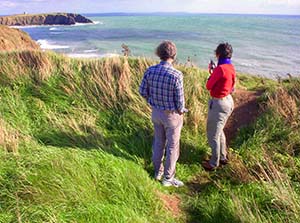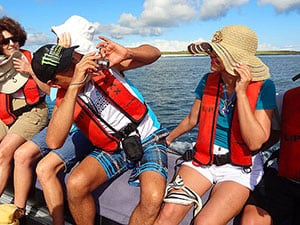Last Updated on September 11, 2021
Estimated reading time: 6 minutes
By Jim Ferri
I started my career as a freelance magazine photographer and early on learned an important fact of (travel) life.
I knew that no matter what happened to me I had to deliver on the assignment. An editor didn’t care if I was incapacitated with a stomach virus or broke my leg or neck. All that mattered was that I deliver the goods on time.
I still follow that mandate, although in today’s world things are a bit easier…all thanks to a small travel medical kit I’ve put together and carry with me.
Staying Healthy and Surviving the Unexpected
You need to be prepared to survive the unexpected and remain healthy, whether you’re in your 20s or your 90s. While traveling, you always need a safety net, your travel medical kit, to get you through a day, night or, possibly, a week. And, of course, you should watch what you eat.
Today, instead of bags of cameras and cases of film, I usually travel only with carryons (one mostly filled with a computer, cameras, reference materials, different plugs, battery chargers, etc.). But I also pack my travel medical kit with things to keep me healthy for a week or more.
In addition to various prescribed medications, my “emergency kit” always contains:
- Advil or Tylenol and antihistamine tablets (the latter in case of an allergic attack)
- Eye drops, extra contacts and lens solution (plus an additional set of glasses)
- Chapstick and skin cream (both heat and air conditioning, especially on a plane, dries out your eyes, lips, and skin)
- Neosporin and a few bandages (blister bandages for toes are a God-send)
- Pepcid and Alka-Seltzer (in case I didn’t realize the food was going to be quite that spicy)
- Sanitizing hand wipes
- Pills to combat an occasional bout of diarrhea, constipation or whatever
- Tissues
- An Ace bandage, which can be a trip-saver should I sprain an ankle.
Believe it or not, I use at least one thing from this “healthy” kit every time I travel. I keep everything in 3-4 zippered plastic pouches, and when I return, I just refurbish the pouch. I keep a supply of everything in my office, so I’m always ready for the next trip.
A Great Product for Your Medical Kit
The most important product in the kit is the sanitizing hand wipes, which I use several times daily when traveling. They’re quick and easy to use to keep you from getting sick from something on your hands.
Over the years I’ve tried numerous brands and found the best to be “Germ-X.” They are soft and resilient 6” X 8” cloths, folded in a 2 ½” x 3 ½” packet. The packet fits comfortably in your pocket, purse or wallet.
Also, they’re rugged enough to wipe down your entire body should you need a shower but can’t get to one. (I can attest to that, as can, I’ve heard, some members of UN missions stationed in far-off lands). Moreover, they also cool your body, a great benefit in hot climates, since they contain alcohol. I once used them to cool someone’s forehead who was going into heat-stroke. It worked.
They’re also relatively inexpensive. You can check the price on Amazon here.
Make Your Travel Medical Kit Small
There’s no sense in carrying all your supplies around with you. From your supplies, you should always take an emergency kit of things you might need only for a day.
Put them in a small case you can carry about on tours, etc. After all, you don’t want to wait until you return to your hotel to get any needed meds. Just make certain you replenish your “day bag” every night.
From a non-medical perspective, I sometimes also tuck away a tiny tube of Krazy Glue and Velcro, and shoelaces. I always take small packets of Woolite, Scotch Tape, and little adhesive page tabs I can stick on the pages of guidebooks, etc. You can include any little thing you might need (a nail clipper, for example) that will clear airport security.
The Key To Being Prepared
The key, though, is to not empty your medicine chest into your luggage. After all, you only need a few tablets of anything until you can get to a pharmacy. Just remember that pharmacies on the Champs-Elysées are more convenient than they are in the jungles of Papua New Guinea. Pack accordingly.
Regarding prescribed medications, carry only enough in your medical kit for the trip’s duration plus 2-3 extra days supply (in case a flight is canceled, or that pill rolls into God-only-knows-whatever-that-is on the hotel rug).
It’s also not a bad idea to get copies of your prescriptions from your doctor and carry them with you. That’s especially important if it’s anything narcotic.
If you check your luggage keep a small portion of most of the medical items in your daily emergency kit. And keep that in your carry-on, along with all your prescription medications and copies, if any, of your prescriptions.
Also, when traveling overseas always look at the website of the Centers for Disease Control and Prevention (CDC), where there’s a wealth of localized info for travelers.
A Tip About Medical Records
Should you have any medical condition, you should also carry a copy of your medical history or records with you. Paper copies usually suffice, but you can put tons of information on a small computer USB flash drive.
The drive can even include copies of cardiograms and other medical tests. It will take up no space in your luggage, but provide doctors anywhere in the world with critical information.
And finally, of course, before you go, speak with your doctor to find out if you need to take any special precautions or get vaccinations to keep you healthy.





Hi Jim,
Great advice. Be prepared for emergencies and travel safely. If you think your email is secure, you can also email prescriptions for everything from glasses to medicine to yourself, making it easily accessible on many devices. Anything vital to your health when you’re a long way from home needs to be readily accessible. You can also leave copies with family and friends at home who can be easily contacted.
Cheers – Stan
Thank you Stan. That’s also great advice.
Jim